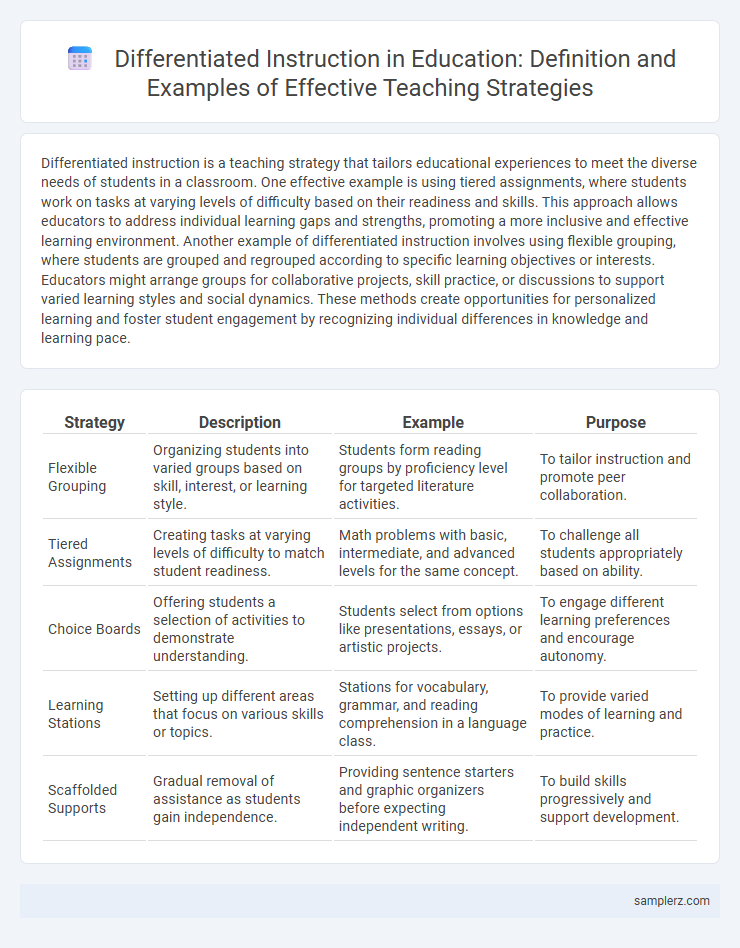Differentiated instruction is a teaching strategy that tailors educational experiences to meet the diverse needs of students in a classroom. One effective example is using tiered assignments, where students work on tasks at varying levels of difficulty based on their readiness and skills. This approach allows educators to address individual learning gaps and strengths, promoting a more inclusive and effective learning environment. Another example of differentiated instruction involves using flexible grouping, where students are grouped and regrouped according to specific learning objectives or interests. Educators might arrange groups for collaborative projects, skill practice, or discussions to support varied learning styles and social dynamics. These methods create opportunities for personalized learning and foster student engagement by recognizing individual differences in knowledge and learning pace.
Table of Comparison
| Strategy | Description | Example | Purpose |
|---|---|---|---|
| Flexible Grouping | Organizing students into varied groups based on skill, interest, or learning style. | Students form reading groups by proficiency level for targeted literature activities. | To tailor instruction and promote peer collaboration. |
| Tiered Assignments | Creating tasks at varying levels of difficulty to match student readiness. | Math problems with basic, intermediate, and advanced levels for the same concept. | To challenge all students appropriately based on ability. |
| Choice Boards | Offering students a selection of activities to demonstrate understanding. | Students select from options like presentations, essays, or artistic projects. | To engage different learning preferences and encourage autonomy. |
| Learning Stations | Setting up different areas that focus on various skills or topics. | Stations for vocabulary, grammar, and reading comprehension in a language class. | To provide varied modes of learning and practice. |
| Scaffolded Supports | Gradual removal of assistance as students gain independence. | Providing sentence starters and graphic organizers before expecting independent writing. | To build skills progressively and support development. |
Understanding Differentiated Instruction Strategies
Differentiated instruction strategies include tiered assignments, which tailor tasks to students' readiness levels, allowing deeper understanding at varied paces. Flexible grouping encourages collaboration among learners with diverse abilities, promoting peer learning and social skills. Learning centers provide targeted focus on specific skills or concepts, adapting content delivery to individual student needs.
Flexible Grouping as a Differentiation Example
Flexible grouping in differentiated instruction allows educators to tailor learning experiences by organizing students into varied groups based on skill level, interests, or learning preferences. This strategy enhances engagement and improves academic outcomes by providing targeted instruction and collaborative opportunities. Research shows flexible grouping fosters peer interaction and supports mastery of content in diverse educational settings.
Tiered Assignments to Meet Varied Readiness Levels
Tiered assignments address varied readiness levels by providing tasks with different levels of complexity and support tailored to students' individual skills in a single classroom setting. This strategy ensures all learners engage meaningfully with the content by adjusting objectives, materials, and outcomes according to their proficiency. Data-driven assessments guide teachers in designing appropriate tiers that promote growth while maintaining curriculum rigor and fostering student motivation.
Incorporating Learning Centers for Strategy Variation
Incorporating learning centers as a differentiated instruction strategy allows educators to cater to diverse student needs by offering varied activities targeting multiple learning styles and skill levels. Each center focuses on specific content or skills, enabling students to engage with material at their own pace and depth, thereby enhancing personalized learning experiences. This method promotes active learning and accommodates individual preferences, improving student motivation and achievement across heterogeneous classrooms.
Adjusting Content with Read-Alouds and Visuals
Differentiated instruction enhances student understanding by adjusting content through read-alouds and visuals, catering to diverse learning styles. Read-alouds support auditory learners by emphasizing tone, pronunciation, and intonation, while visuals like charts and graphic organizers aid visual learners in grasping complex concepts. Incorporating these strategies improves engagement, information retention, and accessibility across varied proficiency levels.
Using Choice Boards for Student Engagement
Choice boards empower students by offering diverse learning activities tailored to varying interests, readiness levels, and learning styles, enhancing engagement in the classroom. This strategy allows educators to differentiate instruction through multiple options such as projects, readings, and multimedia tasks, promoting autonomy and deeper understanding. Research indicates that choice boards improve motivation and accommodate diverse learners by providing structured yet flexible pathways to mastery.
Scaffolded Instruction Tailored to Learners
Scaffolded instruction tailored to learners involves breaking complex tasks into manageable steps, providing supports such as visual aids, guided questions, and modeling to promote understanding and independence. Teachers adjust scaffolds based on individual students' readiness and learning profiles, ensuring targeted support aligns with their cognitive and developmental needs. This strategy enhances engagement and skill mastery by fostering gradual release of responsibility from teacher to student.
Providing Varied Assessment Formats
Providing varied assessment formats in differentiated instruction enables educators to accommodate diverse learning styles and abilities, such as offering multiple-choice tests, oral presentations, and project-based evaluations. This approach enhances student engagement by allowing learners to demonstrate understanding through their preferred modalities, promoting equitable opportunities for success. Tailoring assessments to individual strengths supports mastery of curriculum standards and fosters deeper comprehension.
Integrating Technology for Personalized Learning
Integrating technology for personalized learning enhances differentiated instruction by utilizing adaptive software that tailors lessons to individual student needs, such as DreamBox for math or ReadWorks for reading comprehension. Interactive platforms like Google Classroom and Seesaw enable teachers to assign varied tasks based on student readiness, interests, and learning profiles. Data analytics from these technologies provide real-time feedback, allowing educators to modify instruction to support diverse learners effectively.
Differentiating Homework for Student Needs
Differentiating homework involves assigning tasks that vary in complexity, format, and support based on individual student readiness, learning profiles, and interests. For example, teachers might provide advanced problem sets for skilled learners, scaffolded worksheets for those needing reinforcement, and project-based assignments for students pursuing deeper exploration. This strategy promotes engagement and mastery by tailoring learning opportunities to diverse student needs outside the classroom.

example of differentiated instruction in strategy Infographic
 samplerz.com
samplerz.com